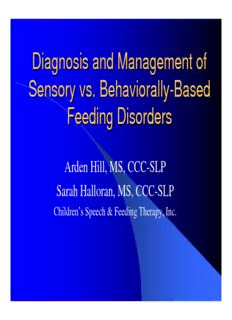
Diagnosis and Management of Sensory vs. Behaviorally PDF
Preview Diagnosis and Management of Sensory vs. Behaviorally
DDiiaaggnnoossiiss aanndd MMaannaaggeemmeenntt ooff SSeennssoorryy vvss.. BBeehhaavviioorraallllyy--BBaasseedd FFeeeeddiinngg DDiissoorrddeerrss Arden Hill, MS, CCC-SLP Sarah Halloran, MS, CCC-SLP Children’s Speech & Feeding Therapy, Inc. PPrreevvaalleennccee Feeding disorders occur in : (cid:122) (Rudolph & Link, 2002) – 25-35% of developmentally normal children – 40-70% of children with developmental disabilities and/or chronic medical conditions SSeennssoorryy IIssssuueess Where do they come from? (cid:122) – Prematurity – Chronic illness – Multiple medical interventions/medications – Underlying neuro issues – Diagnosis with SI as a component SSeennssoorryy IIssssuueess Where do they come from? (cid:122) – Unpleasant oral-tactile experiences – Delayed introduction of oral feeds – GI issues BBeehhaavviioorraall IIssssuueess Where do they come from? (cid:122) – Bad habits/desperation – Poor limit setting – Lack of mealtime structure and routine – Passive eating with distractions – Inconsistent expectations re: eating SSeennssoorryy IIssssuueess wwiitthh BBeehhaavviioorraall OOvveerrrriiddee Behaviors often stem from somewhere else (cid:122) Normal cognition yields behavioral issues (cid:122) Children with underlying sensory issues (cid:122) rarely just eventually eat Underlying issues must be addressed (cid:122) Similar rules imposed with eating as with (cid:122) other behavioral management SSeennssoorryy IIssssuueess -- PPrreesseennttaattiioonn Often avoids whole foods or texture groups (cid:122) Difficulty tolerating sensory input – (cid:122) sight/smell/touch/taste Eats the same regardless of people/place (cid:122) Overstuffs oral cavity/takes tiny bites (cid:122) Stores food “for later” (cid:122) Gags as a sensory response (cid:122) Excessive drooling (cid:122) BBeehhaavviioorraall IIssssuueess -- PPrreesseennttaattiioonn Rarely selective avoidance (cid:122) Eats better for certain people/places (cid:122) Gags to get attention (cid:122) Rarely underlying neuro or medical issue (cid:122) AAbbnnoorrmmaall SSeennssoorryy RReessppoonnsseess Hyposensitivity (cid:122) Hypersensitivity (cid:122) Assess the child’s comfort level with food (cid:122) within the sensory domain and begin your treatment at that level HHyyppoosseennssiittiivviittyy “Reduced awareness of non-nutritive and nutritive stimuli in the mouth, heightened sensory threshold to oral input” Poor suck (cid:122) Liquid pooling (cid:122) Liquid loss (cid:122) Gag (protection vs. rejection) (cid:122) Overstuffing/pocketing (cid:122)
Description: